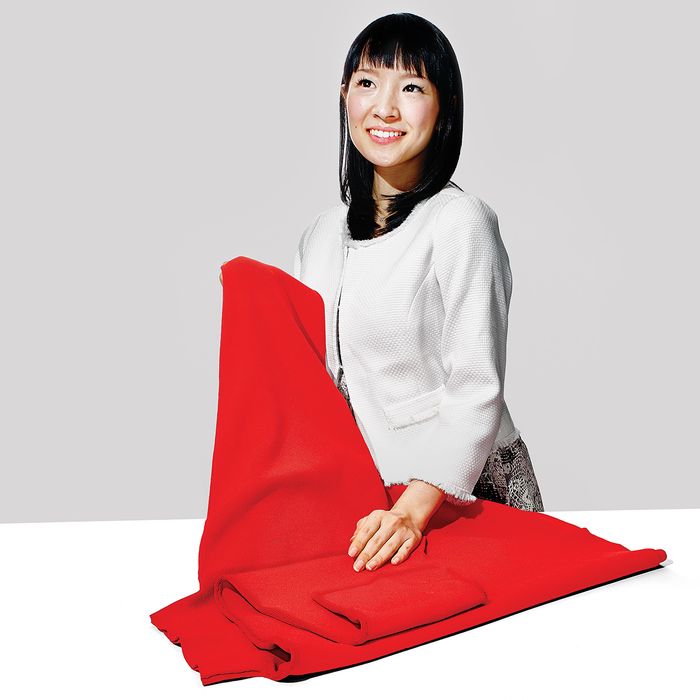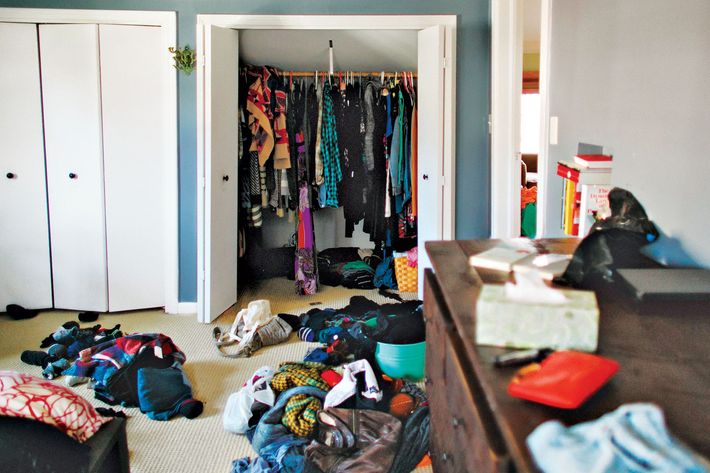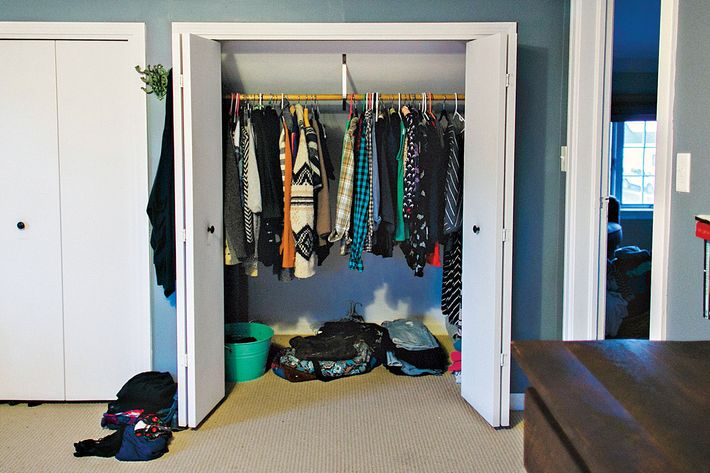
As a physical presence, Marie Kondo has more in common with a snowflake than with the flesh-and-blood humans around her. She speaks softly, wears white, and doesn’t so much make an entrance as drift to a halt on the stormy day when we meet. Most celebrities of her magnitude have a force field. Kondo, standing about five feet tall in shiny patent-leather heels, has none—and yet she’s so famous in Japan that she can no more ride the Tokyo subway than Beyoncé could.
At 30 years old, Kondo has written four best-selling books about the art of tidying, including The Life-Changing Magic of Tidying Up, her first book translated into English and a runaway best seller. Fans of her decluttering techniques call themselves Konverts and use the author’s name as a verb: “Good day today,” wrote one in a parenting forum. “Kondoed fridge before shopping delivery.” From another: “It seems mundane but I’ve Kondo’d some deodorant that I didn’t like the smell of.” Konverts live for the high of domestic purging. They call it Kondomania.
The author’s formal study of neatness began at age 5, when feng shui principles became trendy in Tokyo. “My mother was applying the method, but to my eye, the house was not tidy enough to have the feng shui effect,” Kondo said, sipping Fiji water through a straw at lunch. She began helping her mother with the housework. “Well, not so much helped, as I was the one who tidied,” Kondo clarified. “I actually executed all the tidying up.”

At 18, she got a part-time job at a Shinto shrine, where she kept order for the shrine elder and sold lucky charms at a kiosk. In college, she studied sociology and wrote a thesis titled “ ‘How to Declutter Your Apartment’—from a sociological perspective,” Kondo said. She worked as a consultant, wrote her first book in three months, and published it in 2010. Sales were fine. Then the 2011 earthquake and tsunami happened.
Kondo’s editor, Tomohiro Takahashi, also at lunch, explained with great tact the catastrophe’s effect on book sales. “The Japanese people suddenly had to ask themselves what was important in their lives. What was the true value of sentimental items? What was the meaning of the items they’d lost? What was the meaning of life?” Sales exploded in the quake’s aftermath. “It was, unfortunately, a fortuitous event,” the editor said. One and a half million copies have been sold to date in Japan.
The book was initially intended as a stopgap. “I had so many clients—a months-long waiting list,” Kondo said. “They requested that I write a book so they could learn about my method while waiting for their consultation.” About half of her clients are married. Historically, the majority have been female. When finished with her salad at lunch, Kondo folded her dirty napkin into a gherkin-size tube and tucked it under the rim of her plate, out of sight. Her plate was spotless.

In Japan more than anywhere else, tidiness is less a virtue than a philosophy of living. The reason is simple: Japanese apartments are tiny, while the range of stuff a person can buy is huge. Disorder results. “Quite a few books about decluttering are published in a year,” Kondo said.
Like any lifestyle guru, Kondo has rules. T-shirts should be folded into taut packets, not floppy slabs. Kitchen sponges belong under the sink. Small change must not be left in piles throughout the house. (It is disrespectful.) The following items should be dumped without delay: credit-card statements, spare buttons, user manuals, makeup samples, mysterious cords. The central law of Kondo’s method is to keep items that “spark joy” in an owner and dispose of items that do not.
Herein lies the charm. In theory, Kondo should translate poorly to American audiences. We don’t like being scolded, we don’t like foreigners telling us how to live, we don’t like our sloppily balled socks treaded on. We don’t like paying $16.99 for 224 pages of nagging. Our roommates and spouses do that for free.
But Kondo doesn’t nag. Instead, she urges a kind of animistic tenderness toward everyday belongings. Socks “take a brutal beating in their daily work, trapped between your foot and your shoe, enduring pressure and friction to protect your precious feet,” she writes. “The time they spend in your drawer is their only chance to rest.” Purses merit similar reverence: “Being packed all the time, even when not in use, must feel something like going to bed on an empty stomach.” Kondo’s thesis—that the world is filled with worthy recipients of mercy, including lightweight-microfiber ones—is as lovely as it is alien. It’s empathy as an extreme sport.
In preparation for our meeting, I had applied Kondo’s folding methods to my dresser, resulting in a full 20 inches of undiscovered spare room. Throughout the day I returned to my drawers, opening them to admire the now-orderly jeans and socks. I felt the pride of a parent on an airplane with a well-behaved child. How polite and agreeable my socks were being! They deserved a cookie.
“It’s typical to feel a sense of serenity after the process,” Kondo said when I told her about my folding.
After lunch it was time for a client visit in Greenwich Village. The apartment—a one-bedroom with billion-foot ceilings, plantation shutters, and a fireplace—was the kind of charm-stuffed dream pad that makes a visitor feel wickedly covetous. A fact that’s unsurprising, since the client was Wendy Goodman, New York’s own design editor. Kondo voyaged inside and absorbed the overstuffed bookshelves, the antique tomato-velvet ottoman, the conch shells, and the silver urns. “At the moment, everything is a big mishmash,” Goodman explained.
Kondo started with the bookshelves. “It’s going to be labor-intensive and time-consuming, but you need to take all the books down and put them on the floor,” she said. “Take them down and spread them in one area. Physically pick each book up, one by one. If the book inspires you, keep it. If not, it goes out. That’s the standard by which you decide.”
“Why can’t I just look at the book?” Goodman asked.
“Because your body is very honest with you,” Kondo replied. “Your body will respond if the book sparks joy.”
Goodman scanned her bookshelf. “That’s a big job,” she said, her voice a little shaky.
“Think of it as an event,” Kondo said. “A festival.”
They moved into Goodman’s home office, which was insulated by stacks of paperwork.
By the end of Kondo’s visit, Goodman was wondering whether she could get a few months off work to undertake a radical decluttering regimen. She gazed around her office, hands clasped. “It must be so wonderful to have a home filled only with things that bring you joy.”
Kondo grasped Goodman’s hand and looked her seriously in the eye. “You can do it,” she said.
*This article appears in the February 9, 2015 issue of New York Magazine.




